Cèsar Favà and Ruth Bagan
Until 9 January 2022, the work will be displayed in the exhibition Il Rinascimento europeo di Antoine de Lonhy, in the Palazzo Madama-Museo Civico d’Arte Antica in Turin. It sheds light on the painter’s work in Catalonia, together with a reproduction of the other work surviving from the same period: the rose window of the church of Santa Maria del Mar, in Barcelona.

Reproduction of the rose window of Santa Maria del Mar and Miralles altarpiece in the exhibition “Il Rinascimento europeo di Antoine de Lonhy”. ©Torino, Palazzo Madama – Museo Civico d’Arte Antica. Su concessione della Fondazione Torino Musei (foto: Studio Fotografico Gonella 2021)
The Miralles altarpiece
The altarpiece of the Virgin, Saint Augustine and Saint Nicholas of Tolentino from the convent of Domus Dei in Miralles (Castellví de Rosanes, Baix Llobregat) is excellent for both its high pictorial quality and for being unique in Catalan panel painting: it is the only known polyptych from the time the painter Antoine de Lonhy (c. 1420 – 1480/90) spent in Catalonia.
By the early years of the twentieth century, the retable was already incomplete and it decorated the high altar of the seventeenth-century church of the convent of Miralles, where it had been brought from the old church and where the space it once occupied is still empty.
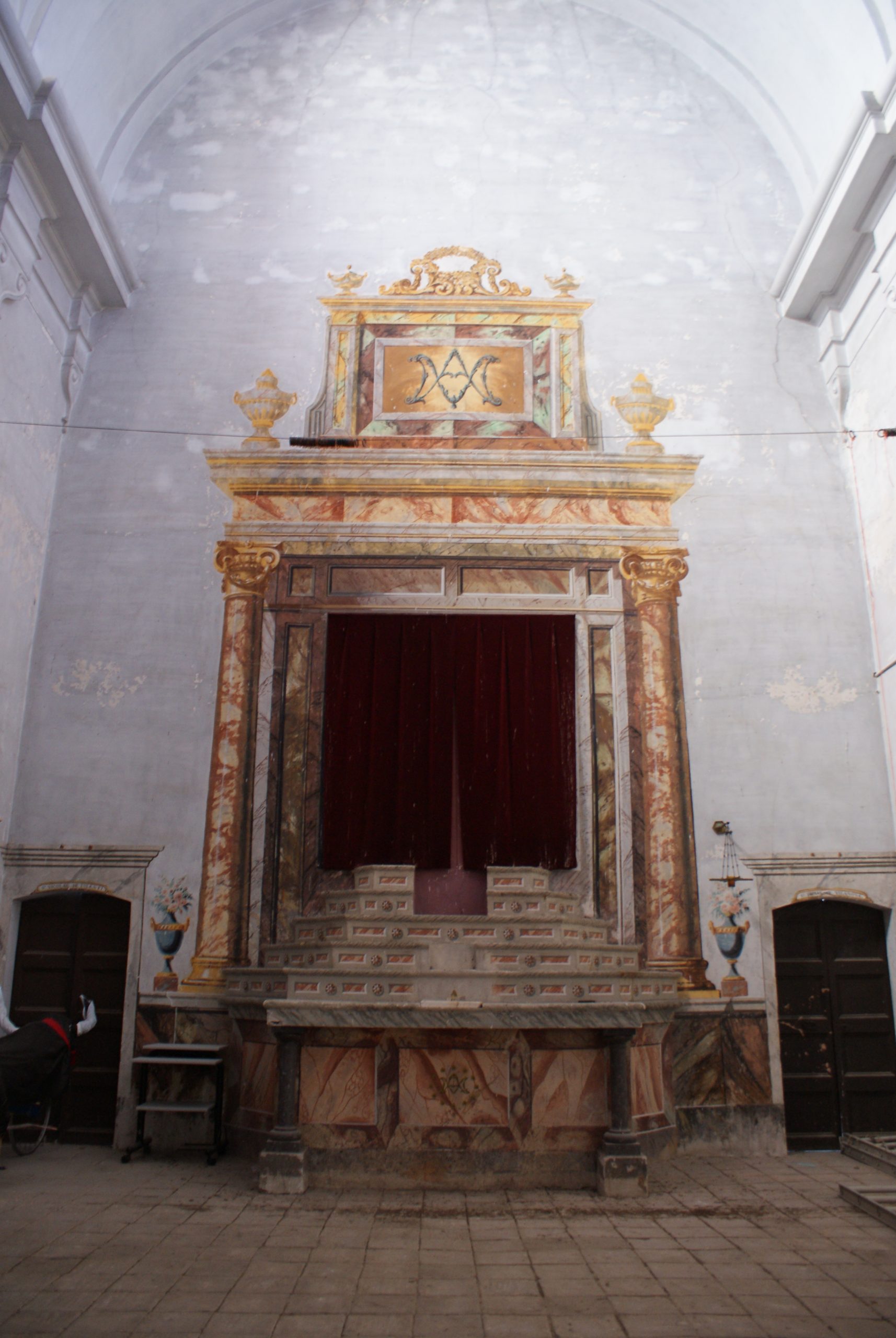
High altar of the modern church of the convent of Miralles. Photo: Cèsar Favà.
However, in 1910 it was already in Barcelona as a result of its sale by the Margarit family, who had owned the convent since 1843. Not long afterwards its surviving parts took different paths. In 1932, the main body of the altarpiece entered what is now the Museu Nacional via the collection of Lluís Plandiura, who had purchased it in the 1920s.

Main body of the altarpiece of the Virgin, Saint Augustine and Saint Nicholas of Tolentino. Circa 1461-1462. Oil, tempera and gold leaf on wood. 206 x 206 x 13 cm. MNAC 5088.
The two panels of the predella belonged to the counts of Perelada, and, successively, to the businessman and politician Miquel Mateu. They are now in the collection of the Museu Castell de Peralada.
Death of Saint Monica. © Museu del Castell de Peralada. / Miracles at the Tomb of Saint Nicholas of Tolentino. © Museu del Castell de Peralada.
Formed by a single panel, the main body of the altarpiece is structured in two levels and three vertical sectors. The Virgin with the Child occupies the central compartment, enthroned and surrounded by angels. She is flanked by the two principal saints of the Augustinian order, to which the convent belonged, with their attributes: Saint Augustine, on the viewer’s left; and on the right Saint Nicholas of Tolentino, who had recently been canonized (1446). The upper register displays three narrative scenes featuring the three crowning figures: in the centre, The Adoration of the Magi or Epiphany; on the right, Saint Augustine Ordaining a Novice, and on the left the Mass for Saint Nicholas of Tolentino. In the two panels of the predella conserved in Perelada two more episodes from the lives of these two saints are depicted: the Death of Saint Monica (mother of Saint Augustine) and the Miracles at the Tomb of Saint Nicholas of Tolentino.
The donor of the work, the merchant Bertran Nicolau (c. 1355-1421), founder of the convent of Miralles and one of the great benefactors of his day, appears kneeling at the feet of the Virgin. He can be identified thanks to the coat of arms situated at the bottom of the Marian throne, containing his monogram (cruciform b intertwined with n). The same coat of arms is also conserved in the mural paintings in the old chapel and on the coffered ceilings of the convent of Miralles, as well as in the monastery of Sant Jeroni de la Murtra, also founded by Nicolau.


Coats of arms of Bertran Nicolau on the coffered ceilings in the convent de Miralles. / Coats of arms of Bertran Nicolau in the mural paintings in the old church of the convent of Miralles. Photos: Cèsar Favà.
Although the work offers references to the donor, its painter was only revealed thanks to a document published at the beginning of last century. This revealed that the altarpiece was already finished by 4 May 1462 and that a sum of money was owed to Antoine de Lonhy for making it. We now know that the long gap in time between the death of Bertran Nicolau, without issue (1421), and the date of the work (c. 1461-1462) could well be due to the long-lasting dispute over the merchant’s will. Moreover, it is thought that the making of the painting must have derived from the contract he was given to design the stained glass for the rose window in the façade of Santa Maria del Mar, signed in June 1460.
Initially recorded in Burgundy, where he was almost certainly born and where he worked for the duke’s chancellor, Nicolas Rolin, no less, in the 1450s Lonhy moved to Toulouse. From there he set out on his brief sojourn around Catalonia, after which he settled permanently in the duchy of Savoy. From this surprising itinerant trajectory a considerable number of works have survived, which clearly show the artist’s versatility: among other things he illuminated manuscripts and painted walls, on wood and on glass, and he made designs for stained-glass windows and for embroideries.
The exhibition in Turin: between risk and opportunity
In 2021, the majority of the artist’s known works were presented in the exhibition “Il Rinascimento europeo di Antoine de Lonhy”, the first retrospective dedicated to the artist. The exibit was divided into two sections, presented in two different places: one in the Diocesan Museum in Susa (from 20 July to 10 October 2021), curated by Vittorio Natale; the other in the Palazzo Madama-Museo Civico d’Arte Antica in Turin (from 7 October 2021 to 9 January 2022), curated by Simone Baiocco and Simonetta Castronovo. For the occasion a rich catalogue has been published with numerous introductory studies and the catalogue files of the works exhibited, edited by Simone Baiocco and Vittorio Natale.
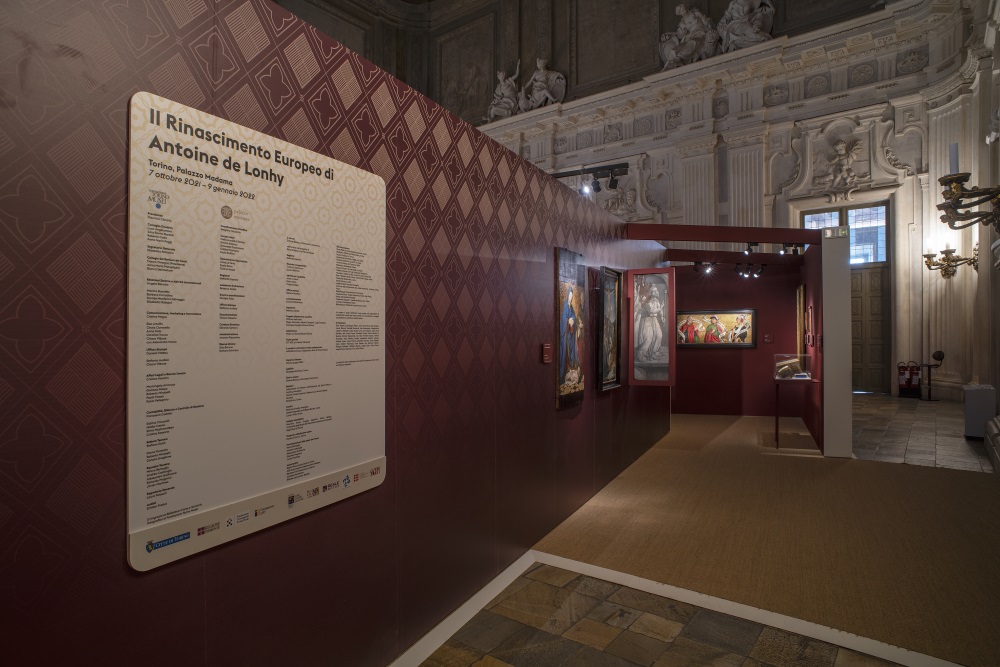
Entrance to the exhibition in the Sala del Senato of the Palazzo Madama in Turin. ©Torino, Palazzo Madama – Museo Civico d’Arte Antica. Su concessione della Fondazione Torino Musei (foto: Studio Fotografico Gonella 2021)
The Museu Nacional has contributed to the exhibition in the Palazzo Madama by loaning the main body of the altarpiece of Miralles. This has made it possible, for the first time, to present the piece alongside Lonhy’s other work. Moreover, it has contributed to bringing together, also for the first time, the surviving parts of the polyptych, thanks to the loan of the two predella compartments by the Museu Castell de Perelada.

Surviving panels from the altarpiece of Miralles in the exhibition. ©Torino, Palazzo Madama – Museo Civico d’Arte Antica. Su concessione della Fondazione Torino Musei (foto: Studio Fotografico Gonella 2021)
The museum’s commitment to the exhibition was also materialized through the loaning of a photograph of the façade of Santa Maria del Mar, by Oriol Maspons. Entitled Porta magnificada. Santa Maria del Mar, it was taken in the context of the publication of Arquitectura gòtica catalana, by Alexandre Cirici Pellicer (1968).

Oriol Maspons, Porta Magnificada. Santa Maria del Mar, Museu Nacional d’Art de Catalunya, MNAC 215629
At the Museu Nacional, the approval of a loan request is based on the assessments made by the Collections and the Conservation Departments, as well as the Security Department. Therefore, the final decision is made taking multiple aspects into consideration, and always seeking the complex balance between access to and conservation of the cultural heritage. From the point of view of conservation, the loaning of a work involves certain risks for its physical integrity, the most important ones arising from moving it and from the conditions it will encounter in the exhibition space. For this reason, one of the prior actions that are carried out at the Museu is the assessment of the “facility report” that is sent by the institution requesting the loan. Factors are analysed, related to the characteristics of the building in which the exhibition is to be held, the entrances, the environmental conditions, the institution’s technical personnel and security. The risks arising from moving the work are assessed, such as the means of transport, the duration of the journey and the route. That makes it possible to determine the most suitable kind of packaging. This risk assessment made from a preventive point of view complements the evaluation of the artwork’s condition, which determines whether it can be loaned and if an intervention is needed in order to be exhibited.

Packing the altarpiece in the Museu Nacional. Photo: Ruth Bagan.
Initially, the request for the loan of the Miralles altarpiece was received with some reservations, given that, due to its characteristics, the painting is particularly vulnerable to movements and climate conditions. It is a panel painting made up of six vertical panels, four horizontal crossbars, and also the pieces that make up the frame, and numerous moulded decorative elements. Measuring 206 x 206 x 13 cm and weighing 96.5 kilograms, the handling of the work was one of the main dangers to face up to if it travelled. At the same time, it was necessary to guarantee suitable atmospheric conditions, given the presence of cracks and isolated, although stable, flaking of the paint layer.
However, the celebration of a retrospective exhibition dedicated to Antoine de Lonhy and the academic interest of the exhibition project were circumstances sufficiently exceptional to make the loan possible. For this reason, efforts were concentrated on taking all the necessary steps to reduce the risks resulting from this operation. These were related to the handling of the painting on the staircase in the Palazzo Madama up to the Sala del Senato, and its installation, and to the climate conditions in this space.
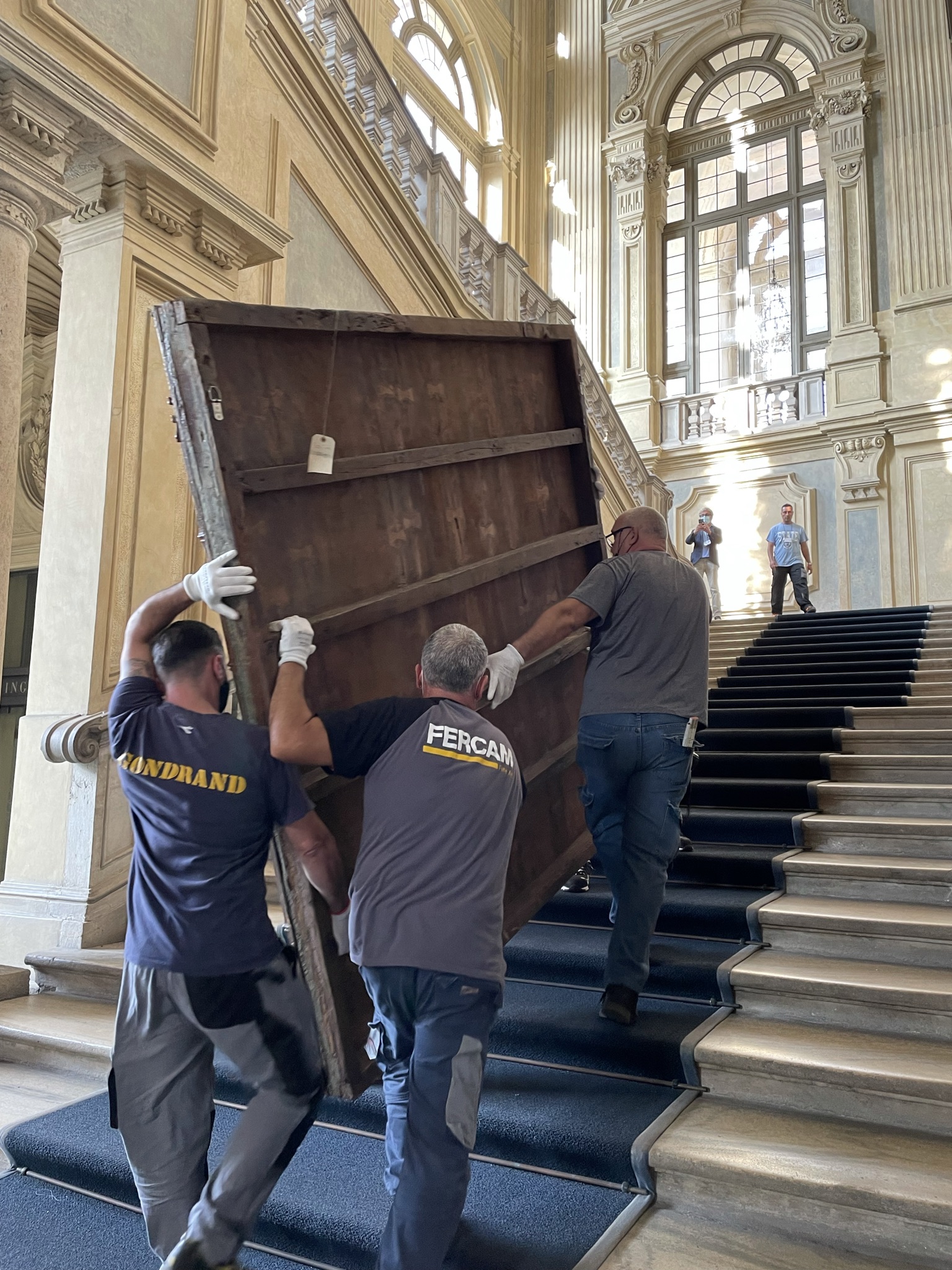
Moving the altarpiece up the staircase in the Palazzo Madama. Photo: Ruth Bagan
Although the building has a climate control system, keeping the relative humidity within a safe range for the work during the winter months – especially dry in Turin – was complicated in a space of this size, despite the existing humidification systems. Consequently, one of the requirements for the loan was that the work should be exhibited in a display case with preconditioned silica gel, for passive relative humidity control, and that the atmospheric conditions had to be monitored for the duration of the exhibition.
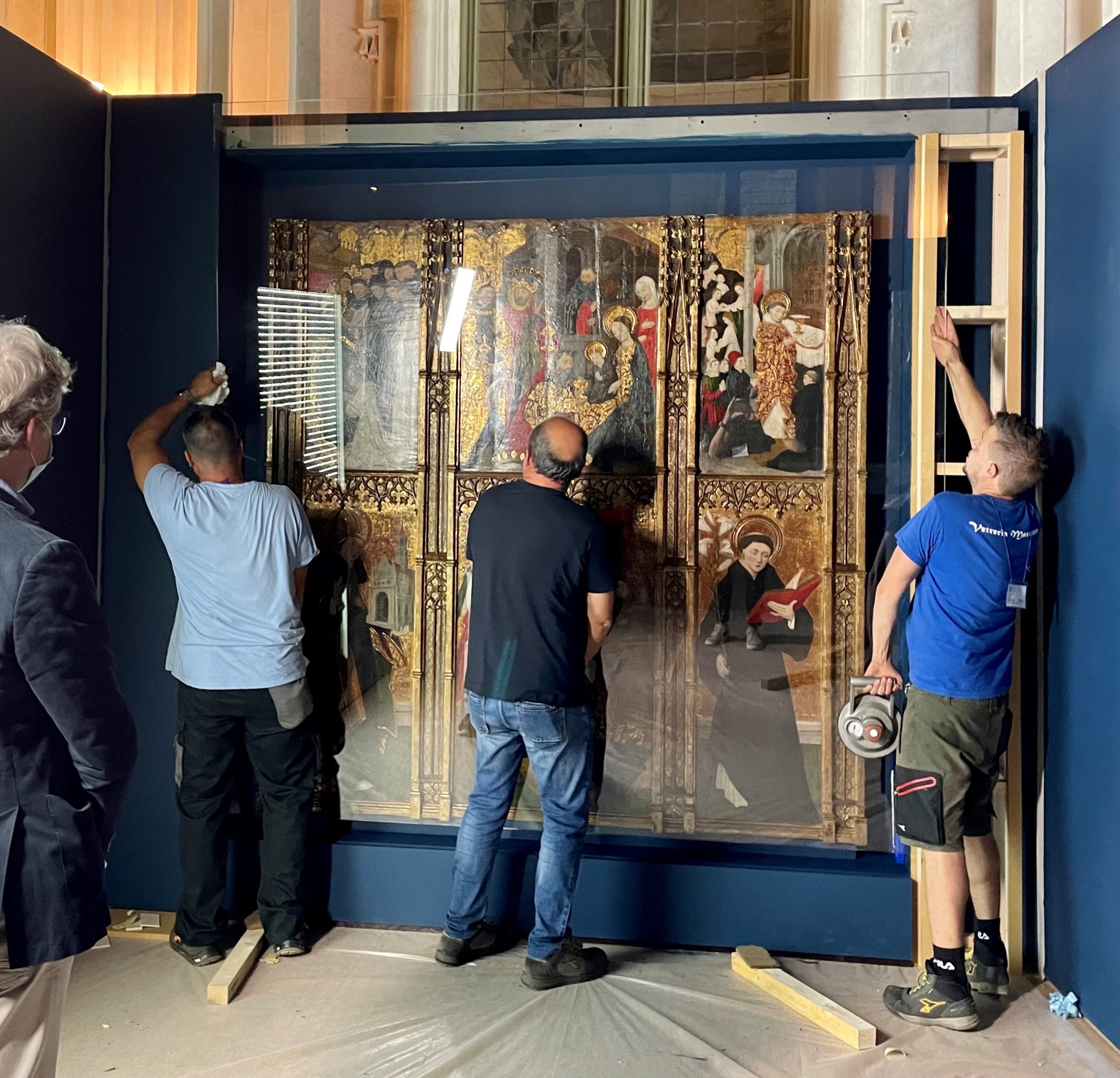
Installing the glass in the altarpiece’s display case. Photo: Ruth Bagan
These factors made it essential for the work to be accompanied by a Museum conservator, to supervise the movements and the installation, and to assess the painting’s condition after these operations. This meant that, from the start, the possibility of couriering via streaming was ruled out, an option that has lately become common, obliged by the current context of the pandemic.
All these measures were preceded by a conditioning of the painting prior to its leaving. The Museum’s conservator, Anna Carreras and Pere de Llobet, worked focusing on the support, and on the fixing, cleaning and retouching of the paint layers, with the two-fold objective of stabilizing the work and make it easier to interpret. On the back, the work was focused on removing the excess epoxy resin and on improving the integration of the grafts and swallow’s tails added in an old restoration. This operation made the male figure in profile and the inscriptions in black ink on the back of the altarpiece more visible.
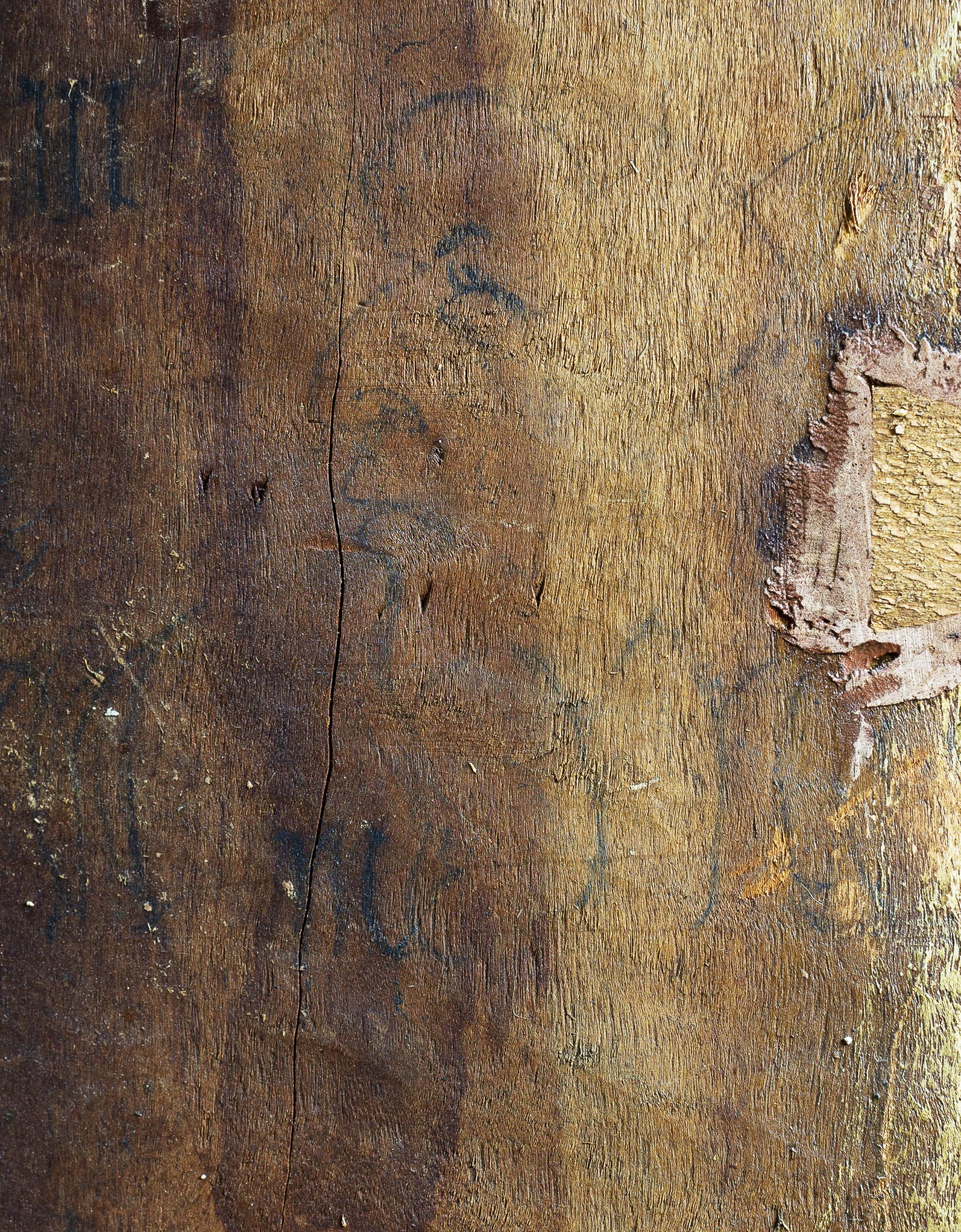
Drawing of a man’s face in profile on the back of the altarpiece. Photo: Ruth Bagan
However, this is not the first time, nor will it be the last, that the Museum has been faced with making this decision. When all is said and done, enhancing the heritage we conserve, and at the same time making it accessible, is part of our job.
Cèsar Favà and Ruth Bagan*
*Our thanks to Jaime Barrachina (†), Maribel González, Susana García, Carles Díaz, Sergi Busquets, Assumpció Royo, Maria Margarit, Manel Margarit, Mireia Berenguer, Roser Cambray, Mireia Mestre, Anna Carreras, Pere de Llobet, Stefania Capraro and Susana Bernad.
To find out more:
– Elsig, Frédéric, Antoine de Lonhy, Milan, 2018.
– Baiocco, Simone; Natale, Vittorio (eds.), Il Rinascimento europeo di Antoine de Lonhy, s.l., 2021 [exhibition catalogue].
– Favà Monllau, Cèsar, “Polittico della Vergine, sant’Agostino e san Nicola da Tolentino”, Baiocco, Simone; Natale, Vittorio (eds.), Il Rinascimento europeo di Antoine de Lonhy, s.l., 2021, pp. 283-285, cat. No. 14 [exhibition catalogue].









